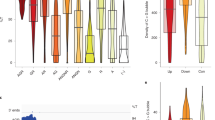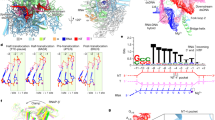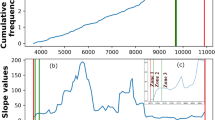Abstract
Intrinsic transcription terminators consist of an RNA hairpin followed by a U-rich tract, and these signals can trigger termination without the involvement of additional factors. Although NusA is known to stimulate intrinsic termination in vitro, the in vivo targets and global impact of NusA are not known because it is essential for viability. Using genome-wide 3′ end-mapping on an engineered Bacillus subtilis NusA depletion strain, we show that weak suboptimal terminators are the principle NusA substrates. Moreover, a subclass of weak non-canonical terminators was identified that completely depend on NusA for effective termination. NusA-dependent terminators tend to have weak hairpins and/or distal U-tract interruptions, supporting a model in which NusA is directly involved in the termination mechanism. Depletion of NusA altered global gene expression directly and indirectly via readthrough of suboptimal terminators. Readthrough of NusA-dependent terminators caused misregulation of genes involved in essential cellular functions, especially DNA replication and metabolism. We further show that nusA is autoregulated by a transcription attenuation mechanism that does not rely on antiterminator structures. Instead, NusA-stimulated termination in its 5′ UTR dictates the extent of transcription into the operon, thereby ensuring tight control of cellular NusA levels.
This is a preview of subscription content, access via your institution
Access options
Subscribe to this journal
Receive 12 digital issues and online access to articles
$119.00 per year
only $9.92 per issue
Buy this article
- Purchase on Springer Link
- Instant access to full article PDF
Prices may be subject to local taxes which are calculated during checkout





Similar content being viewed by others
References
Peters, J. M., Vangeloff, A. D. & Landick, R. Bacterial transcription terminators: the RNA 3′-end chronicles. J. Mol. Biol. 412, 793–813 (2011).
Wilson, K. S. & von Hippel, P. H. Transcription termination at intrinsic terminators: the role of the RNA hairpin. Proc. Natl Acad. Sci. USA 92, 8793–8797 (1995).
Gusarov, I. & Nudler, E. The mechanism of intrinsic transcription termination. Mol. Cell 3, 495–504 (1999).
Komissarova, N., Becker, J., Solter, S., Kireeva, M. & Kashlev, M. Shortening of RNA:DNA hybrid in the elongation complex of RNA polymerase is a prerequisite for transcription termination. Mol. Cell 10, 1151–1162 (2002).
Mitra, A., Angamuthu, K., Jayashree, H. V. & Nagaraja, V. Occurrence, divergence and evolution of intrinsic terminators across eubacteria. Genomics 94, 110–116 (2009).
Potter, K. D., Merlino, N. M., Jacobs, T. & Gollnick, P. TRAP binding to the Bacillus subtilis trp leader region RNA causes efficient transcription termination at a weak intrinsic terminator. Nucleic Acids Res. 39, 2092–2102 (2011).
Schmidt, M. C. & Chamberlin, M. J. nusA protein of Escherichia coli is an efficient transcription termination factor for certain terminator sites. J. Mol. Biol. 195, 809–818 (1987).
Farnham, P. J., Greenblatt, J. & Platt, T. Effects of NusA protein on transcription termination in the tryptophan operon of Escherichia coli. Cell 29, 945–951 (1982).
Gusarov, I. & Nudler, E. Control of intrinsic transcription termination by N and NusA: the basic mechanisms. Cell 107, 437–449 (2001).
Yakhnin, A. V. & Babitzke, P. NusA-stimulated RNA polymerase pausing and termination participates in the Bacillus subtilis trp operon attenuation mechanism in vitro. Proc. Natl Acad. Sci. USA 99, 11067–11072 (2002).
Ingham, C. J., Dennis, J. & Furneaux, P. A. Autogenous regulation of transcription termination factor Rho and the requirement for Nus factors in Bacillus subtilis. Mol. Microbiol. 31, 651–663 (1999).
Cardinale, C. J. et al. Termination factor Rho and its cofactors NusA and NusG silence foreign DNA in E. coli. Science 320, 935–938 (2008).
Vogel, U. & Jensen, K. F. NusA is required for ribosomal antitermination and for modulation of the transcription elongation rate of both antiterminated RNA and mRNA. J. Biol. Chem. 272, 12265–12271 (1997).
Miller, C. M., Baumberg, S. & Stockley, P. G. Operator interactions by the Bacillus subtilis arginine repressor/activator, AhrC: novel positioning and DNA-mediated assembly of a transcriptional activator at catabolic sites. Mol. Microbiol. 26, 37–48 (1997).
Yakhnin, A. V., Yakhnin, H. & Babitzke, P. Function of the Bacillus subtilis transcription elongation factor NusG in hairpin-dependent RNA polymerase pausing in the trp leader. Proc. Natl Acad. Sci. USA 105, 16131–16136 (2008).
Yakhnin, A. V. & Babitzke, P. Mechanism of NusG-stimulated pausing, hairpin-dependent pause site selection and intrinsic termination at overlapping pause and termination sites in the Bacillus subtilis trp leader. Mol. Microbiol. 76, 690–705 (2010).
Mah, T. F., Kuznedelov, K., Mushegian, A., Severinov, K. & Greenblatt, J. The alpha subunit of E. coli RNA polymerase activates RNA binding by NusA. Genes Dev. 14, 2664–2675 (2000).
Worbs, M., Bourenkov, G. P., Bartunik, H. D., Huber, R. & Wahl, M. C. An extended RNA binding surface through arrayed S1 and KH domains in transcription factor NusA. Mol. Cell 7, 1177–1189 (2001).
Yang, X. et al. (2009). The structure of bacterial RNA polymerase in complex with the essential transcription elongation factor NusA. EMBO Rep. 10, 997–1002 (2009).
Ha, K. S., Toulokhonov, I., Vassylyev, D. G. & Landick, R. The NusA N-terminal domain is necessary and sufficient for enhancement of transcriptional pausing via interaction with the RNA exit channel of RNA polymerase. J. Mol. Biol. 401, 708–725 (2010).
Toulokhonov, I., Artsimovitch, I. & Landick, R. Allosteric control of RNA polymerase by a site that contacts nascent RNA hairpins. Science 292, 730–733 (2001).
Pan, T., Artsimovitch, I., Fang, X. W., Landick, R. & Sosnick, T. R. Folding of a large ribozyme during transcription and the effect of the elongation factor NusA. Proc. Natl Acad. Sci. USA 96, 9545–9550 (1999).
Cohen, S. E. et al. Roles for the transcription elongation factor NusA in both DNA repair and damage tolerance pathways in Escherichia coli. Proc. Natl Acad. Sci. USA 107, 15517–15522 (2010).
Nicolas, P. et al. Condition-dependent transcriptome reveals high-level regulatory architecture in Bacillus subtilis. Science 335, 1103–1106 (2012).
Peters, J. M. et al. Rho and NusG suppress pervasive antisense transcription in Escherichia coli. Genes Dev. 26, 2621–2633 (2012).
Naville, M. & Gautheret, D. Premature terminator analysis sheds light on a hidden world of bacterial transcriptional attenuation. Genome Biol. 11, R97 (2010).
Davies, K. M., Dedman, A. J., van Horck, S. & Lewis, P. J. The NusA:RNA polymerase ratio is increased at sites of rRNA synthesis in Bacillus subtilis. Mol. Microbiol. 57, 366–379 (2005).
Yakhnin, H. et al. Complex regulation of the global regulatory gene csrA: CsrA-mediated translational repression, transcription from five promoters by Eσ70 and EσS, and indirect transcriptional activation by CsrA. Mol. Microbiol. 81, 689–704 (2011).
Du, H. & Babitzke, P. trp RNA-binding attenuation protein-mediated long distance RNA refolding regulates translation of trpE in Bacillus subtilis. J. Biol. Chem. 273, 20494–20503 (1998).
Acknowledgements
Illumina library preparation and sequencing was performed at the Penn State Genomics Core Facility. The authors thank P. Lewis and M. Fujita for providing NusA and σA antibodies, respectively. E. coli NusA was provided by C. Squires. This work was supported by National Institutes of Health grant GM098399 to P.B.
Author information
Authors and Affiliations
Contributions
S.M. performed all experiments except for illumina library generation and sequencing. A.V.Y. discovered NusA-dependent termination in vitro. A.S. and I.A. processed raw sequencing data, mapped the sequencing reads to the genome and developed computational algorithms. P.B. and S.M. analysed the processed data. S.M. and P.B. wrote the manuscript. P.B. supervised the project.
Corresponding author
Ethics declarations
Competing interests
The authors declare no competing financial interests.
Supplementary information
Supplementary Information
Supplementary Methods, References and Figures 1–6. (PDF 1568 kb)
Supplementary Table 1
RNA 3′ ends identified by 3′ end-mapping. (XLSX 241 kb)
Supplementary Table 2
The effect of NusA on terminators. (XLSX 289 kb)
Supplementary Table 3
Genes that are differentially expressed twofold or more (p-adj < 0.05) upon NusA depletion. (XLSX 95 kb)
Rights and permissions
About this article
Cite this article
Mondal, S., Yakhnin, A., Sebastian, A. et al. NusA-dependent transcription termination prevents misregulation of global gene expression. Nat Microbiol 1, 15007 (2016). https://doi.org/10.1038/nmicrobiol.2015.7
Received:
Accepted:
Published:
DOI: https://doi.org/10.1038/nmicrobiol.2015.7
This article is cited by
-
Metagenomic approach to infer rumen microbiome derived traits of cattle
World Journal of Microbiology and Biotechnology (2023)
-
Comprehensive transcription terminator atlas for Bacillus subtilis
Nature Microbiology (2022)
-
Clusters of hairpins induce intrinsic transcription termination in bacteria
Scientific Reports (2021)
-
Chance and pleiotropy dominate genetic diversity in complex bacterial environments
Nature Microbiology (2019)
-
Full-length RNA profiling reveals pervasive bidirectional transcription terminators in bacteria
Nature Microbiology (2019)



